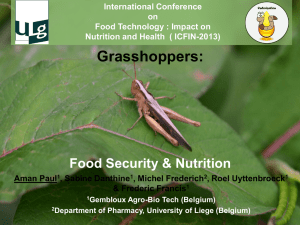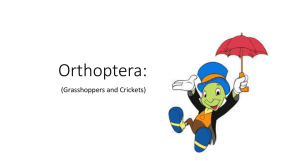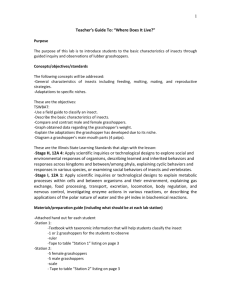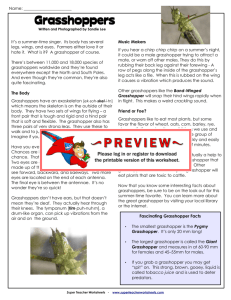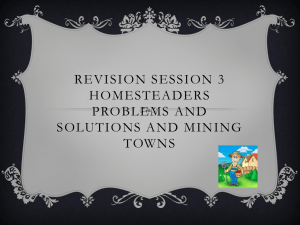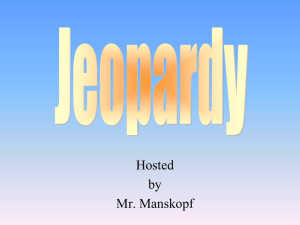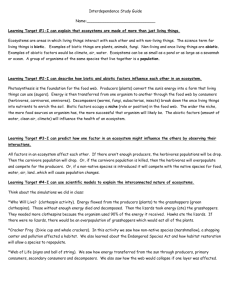1 - Society for the Advancement of American Philosophy
advertisement
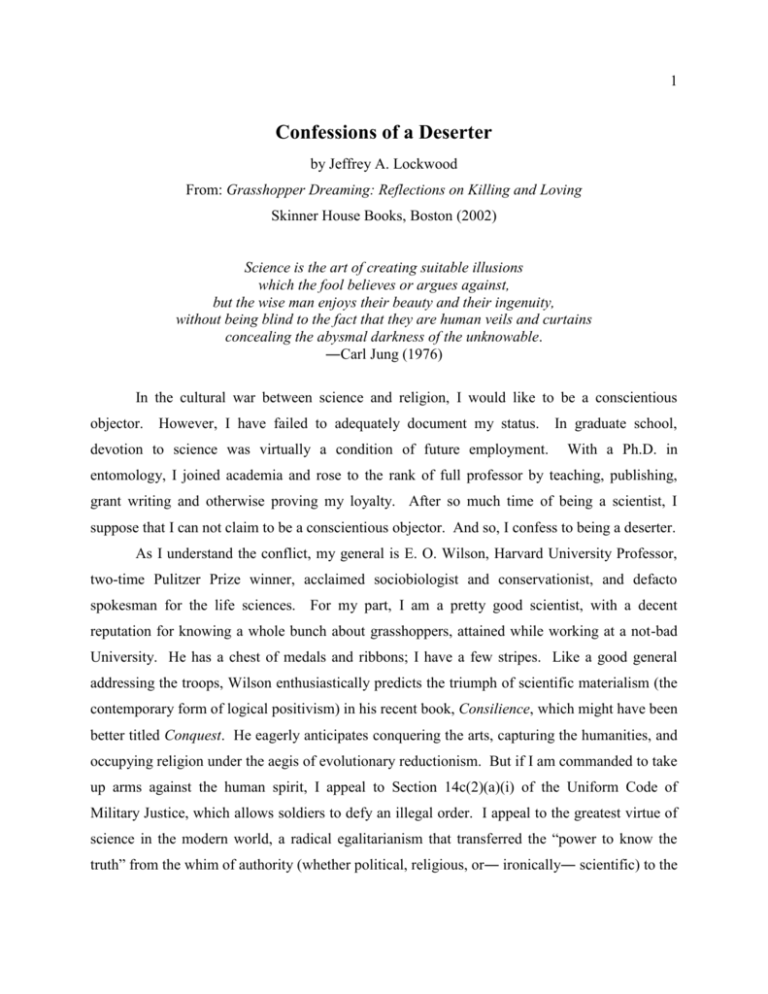
1 Confessions of a Deserter by Jeffrey A. Lockwood From: Grasshopper Dreaming: Reflections on Killing and Loving Skinner House Books, Boston (2002) Science is the art of creating suitable illusions which the fool believes or argues against, but the wise man enjoys their beauty and their ingenuity, without being blind to the fact that they are human veils and curtains concealing the abysmal darkness of the unknowable. ―Carl Jung (1976) In the cultural war between science and religion, I would like to be a conscientious objector. However, I have failed to adequately document my status. devotion to science was virtually a condition of future employment. In graduate school, With a Ph.D. in entomology, I joined academia and rose to the rank of full professor by teaching, publishing, grant writing and otherwise proving my loyalty. After so much time of being a scientist, I suppose that I can not claim to be a conscientious objector. And so, I confess to being a deserter. As I understand the conflict, my general is E. O. Wilson, Harvard University Professor, two-time Pulitzer Prize winner, acclaimed sociobiologist and conservationist, and defacto spokesman for the life sciences. For my part, I am a pretty good scientist, with a decent reputation for knowing a whole bunch about grasshoppers, attained while working at a not-bad University. He has a chest of medals and ribbons; I have a few stripes. Like a good general addressing the troops, Wilson enthusiastically predicts the triumph of scientific materialism (the contemporary form of logical positivism) in his recent book, Consilience, which might have been better titled Conquest. He eagerly anticipates conquering the arts, capturing the humanities, and occupying religion under the aegis of evolutionary reductionism. But if I am commanded to take up arms against the human spirit, I appeal to Section 14c(2)(a)(i) of the Uniform Code of Military Justice, which allows soldiers to defy an illegal order. I appeal to the greatest virtue of science in the modern world, a radical egalitarianism that transferred the “power to know the truth” from the whim of authority (whether political, religious, or― ironically― scientific) to the 2 shared, first-hand experience of the people. Contrary to Wilson’s interpretation of history, the inheritors of the Enlightenment were people like Ralph Waldo Emerson. When I officiated high school basketball to earn a bit of money in college, there was a saying that the difference between high school, college, and professional referees was that in high school games the ref says, “I call them as I see them,” in college it’s, “I call them what they are,” and according to the pro, “They are what I call them.” Taxonomy, the foundation of all biology, is very much the same as basketball officiating. The expert, who has legitimately earned the respect and acquiescence of the scientific community through devotion, hard work, consistency, and experience, is granted the power to arbitrate the classification and naming of life forms. But in science, the power to define reality is subject to revocation via peer review. Moreover, one’s authority is transient― future scientists can overturn previous decisions. As such, science is a living creation, operating through the tacit acceptance of society. Compared to royal proclamation or papal edict, science’s reliance on earned authority and peer consensus is a reasonable and legitimate approach to organizing human understanding of the natural world. But it can be unsettling to experience the “they-are-what-I-call-them” creation of reality through this subjective process. In one of my early submissions for publication in a scientific journal, I was taken to task for using the term “grasshopper communities.” A reviewer asserted, with all of the brutal animosity that anonymity allows, that I was clearly a neophyte in the field and that there was no ecological evidence that grasshoppers formed “communities” (systems of organisms with a high degree of interdependence). I took my lumps, replaced “community” with “assemblage” (an ecologically neutral term) and had the paper accepted. A couple of years later, I was preparing a manuscript on the extinct Rocky Mountain locust, the insect that blackened the skies of the early pioneers and then disappeared at the turn of the last century. We had found some fragments of grasshoppers in the glaciers of Montana and determined them to be the remains of the Rocky Mountain locust. However, identifications based on incomplete specimens are dicey, so I enlisted my colleague, Dr. Robert Pfadt, to take a look at the material. This was a strategically brilliant maneuver, as a reviewer of the paper even went so far as to comment that while my expertise in the area was questionable, if Dr. Pfadt’s 40 years of work on grasshoppers decreed 3 that the fragments were those of the Rocky Mountain locust then the evidence was incontrovertible. Now that I have 15 years of experience in grasshopper ecology, biology, and management, and over 100 scientific papers and book chapters to my credit, I can make my own claims. I even used the term “grasshopper community” in a recent paper and asserted the occurrence of various species without inciting the ire of my peers. My experience has convinced me that grasshoppers form communities, functionally cooperating and facilitating one another’s existence in a myriad of complex relationships. But what changed were my perception of the grasshoppers and the scientific community’s perception of me― not the grasshoppers. In a complex, information-rich world, empowering a class of earned elites to define reality has some virtues, but the hazard comes when we begin to think that scientists have exclusive access to absolute truth. I don’t want freshman biology students renaming species, but neither do I want them dumbly acceding the essence of nature to scientific authority. While scientists might endlessly frustrate the public with extensively qualified, tenuous conclusions (e.g., “It appears that under the conditions in which our observations were made, this chemical may have the potential to...”), they are singularly unwilling to allow other epistemologies, or ways of knowing, to share the stage. Science has an immense stake in retaining and expanding its power, as such authority translates into tremendous social resources. For E. O. Wilson, perhaps the most strident scientific materialist of our times, morality can be empirically derived and religion can be dismissed as an evolutionary by-product. I would not advocate a form of epistemological relativism in which any question can be answered with any method (mathematical theorems are not proven by prayer, despite my desperate entreaties during geometry exams), but for the big questions of the world― questions that include issues inaccessible to material reductionism― there needs to be scientific humility and epistemological pluralism. The question of human existence is a matter of both how we came to be (the legitimate purview of science) and why we came to be (the valid realm of religion). For scientific texts to assert that there is no purpose or direction in evolution is as unfounded as the religious tracts that claim to interpret fossil evidence and geomorphology in terms of the Bible. Science has no method, test, or instrument to detect meaning in the universe. 4 Scientific humility is hard to find when the stakes for cultural conquest are immense and growing ever larger. In a society that fills the days of its people with the complex process of acquiring and consuming a growing list of goods and services, we are coming to the point where we are too busy to figure out what is real for ourselves and the whole scheme seems too complex to comprehend in any case. So we fund our sacred and secular authorities to work it out for us, dividing our faith and our dollars between religion and science in the hope that the Invisible Hand of God and Mystery of Mathematics will resolve the big questions without our having to participate. In such a competition it is no wonder that science claims epistemological superiority― the spoils are not just enormous wealth and prestige, they literally include the human mind. When my son was about 3 years old, he had the usual confusions about the rules of language. However, he also exhibited what was either an interesting grammatical error or a compelling metaphysical insight. Ethan used the pronoun “who” for all objects in his world. He spoke of the “blanket who I slept with” and the “cat who had stripes”. Both he and his sister are very empathetic and gentle children, and Ethan’s language seemed to express his belief that he was immersed in a world of fellow beings. Eventually, we played our role as parents and definers-of-reality and taught him to use “that” and “which” in reference to objects. Maybe someday Ethan will read Martin Buber’s classic, I and Thou, and decide that the world is composed of “who” (or Thou) after all. Buber contends that humans enter into relationships with the world using predominantly an I-It association, precluding the possibility of mutuality or reciprocity. An “It” can be experienced and used, but a person fully comes into being through a “Thou”. Such reciprocity and association “makes life heavier but heavy with meaning.” Buber maintains that there are times and places where a relationship can not be I-Thou by virtue of its goal. A therapist is a patient’s instrument to regain health, and an animal may be a scientist’s means to an ends. In pursuing some legitimate goals, we treat portions of the world as objects. But the human potential can not be reached by pursuing only the knowledge that comes in this manner. Science is a celebration of the I-It relationship, but as Loren Eiseley asked, “Is there something here we fear to face, except when clothed in safely sterilized professional speech? 5 Have we grown reluctant in this age of power to admit mystery and beauty into our thoughts, or to learn where power ceases?”. How much power will science lose if scientists admit the limits of objectivity and materialism? The answer lies, perhaps, in whether science can find a way to allow transcendence while maintaining its integrity. Brian Swimme has proposed such a method by suggesting that what we hold to be objective perceptions of the world are co-creations― emergent realities subject to scientific exploration and interpretation. In The Universe is a Green Dragon, he asserts that, “When you stand in the presence of the moon, you become a new creation ... the human awareness could never know the throbbing presence of the moon and all the intensity of feelings were it not for the moon itself. These feelings are as much the creation of the moon as they are of the human.” This does not portend the end of astronomy, only a deeper understanding of the intimacy between the astronomer and the heavens. As he notes with Thomas Berry in The Universe Story, the feeling of awe that a climber might experience on a mountain― or the sense of wonder that permeates the geologist who comprehends the forces and time that created the mountain― is not created by the human alone. These feelings are neither subjective fantasies of ours nor objective experiences of the mountain; they are personally significant and mutually evoked. They transcend scientific analysis, but they do not negate its value. As such, science is a necessary but not sufficient mode of understanding. The exploration of meaning complements, but does not reduce to, the work of science. In the 1980s, I began my work in applied ecology of rangeland grasshoppers (my favorite euphemism for pest management) by asking how we could most efficiently control their population outbreaks. I perceived these events to be objective, natural phenomena that we could understand and then manipulate. However, I soon discovered that an outbreak was an event with a reality arising from a remarkable admixture of history (the number of grasshoppers capable of damaging wheat decades earlier had been institutionally fixed as an outbreak threshold), policy (the US Department of Agriculture’s involvement in grasshopper control defined the methods of actually delineating an outbreak), economics (state and federal subsidies for control programs dictated the minimum area of an outbreak), and science (the statistical carrying capacity of the rangeland – an arcane calculation with unresolved ecological interpretations – was factored into 6 the definition). Of their own accord, grasshopper populations declined in the early 1990s, and I struggled to find infestations on which to apply my objective, scientifically derived control tactics. However, as I spent more time with grasshoppers, I came to ask how we (humans and grasshoppers) could exist together in a relationship that was created by both their existence and our perceptions. With this understanding came a remarkable series of ecological events. The conditions necessary to explore coexistence were abundantly available, as if the grasshoppers were participating in the effort to find a way for ranchers and insects to co-inhabit the Wyoming prairies. Rather than attempting to totally eliminate large-scale, high-density outbreaks, we now try to thin infestations, understanding the importance of leaving enough grasshoppers in the field to sustain the predator and parasite populations that will re-establish natural constraints. We’ve developed methods that use 98% less insecticide than the tactics available in 1990. Describing these approaches as a co-creation of the grasshoppers and myself would rankle my scientific colleagues and my environmentalist friends. The skeptics of our approach, which involves applying low rates of safer insecticides in widely spaced swaths (rather than high rates of broad-spectrum insecticides in blanket coverage), want to know exactly how and why such a method works before endorsing its use. We are working to untangle the complex processes that account for its success, including the roles of cannibalism, grasshopper movement, and conservation of natural enemies. But for now my best answer is that it works because the grasshoppers, as collaborators in creating the reality of the rangeland, allow it to work. James Gibson coined the noun “affordance” to describe the mutuality that emerges in the context of the human-nature relationship. For example, in mountaineering a human does not climb a rock – the boulder affords footholds and handholds, creating a passage. In the same way, the scientist is afforded access to the universe not by forcing his or her way through a passive and inert matrix of material existence but via the paths and openings― affordances― that arise in relationship. Understanding the world through dominance, like forcing your way up a rock face, might provide short-term success, but it feeds a false sense of power. Consider the entomologists who― in the early, giddy days of DDT― told children to be sure to collect specimens of pest insects because insecticides would soon eliminate these species from the landscape. Today DDT is banned and the pests are flourishing. 7 In a 1998 lecture to the university community, I explained some of my struggles with killing insects while trying to maintain both my scientific credibility and my spiritual accountability. I began with these words, “I love irony and paradox― they are the source of much creative energy and can become doorways to deeper understanding. I recently encountered Theodore Roszak’s argument that modern society, through the collusion of science and religion, with the passive assent of humanities and the arts, has emerged as the most idolatrous culture in human history. This is a disturbing analysis, given our pride in having― supposedly― driven such misguided perceptions from our worldview. But Roszak seems to be onto something with the definition of idolatry as, “a state of consciousness in which the particular is mistaken for the ultimate”. In more familiar terms, an idol is a thing or place that is misunderstood to be nothing more than its material existence. For example, one might mistake a grotto, a tree, or a grasshopper for literally being a god, a truth, or an experience, with nothing more lying deeper or hidden― a symbol devoid of transcendence. This sort of ontological error is most commonly associated with pagans, who it seems never actually believed the sorts of things that were (and are) ascribed to them. Rather, they perceive objects and places as local manifestations of a universal presence. The supposed idol actually functions as a path to transcendence.” During the questioning, I responded to a student’s query about science education with the ironic observation that in biology, the putative science of life, we spend an inordinate amount of time killing things and studying dead specimens. A colleague in zoology jumped in, claiming that, “The difference between zoology and agriculture is that we kill to understand. You kill just to kill.” I replied that killing a rat and treating the animal merely as an object for dissection is no more noble than spraying a field of grasshoppers and treating them as an obstacle to economic prosperity. One’s relationship with another life form was as critical as one’s abstraction of social benefit. To which another colleague argued that he killed fish as a means of understanding their physiology, which would eventually translate into improved fisheries management. The central importance of mindfulness and intentionality faded into the background as we discussed whose 8 science had the loftier goals. What I truly regret was not expressing my core understanding: I had entered the land and knew― not through economic rationalization, environmental quantification, or ecological experimentation, but through experience, intuition, and humility― that it would accept ranchers, if the grasshoppers were respected and included in the co-creation of the prairie. To adapt the line of thought advanced by Swimme and Berry, in a biologically meaningful sense the prairie is a creation of the grasshopper. These insects have sculpted plant communities, cycled nutrients, hosted parasites, fed wildlife, and distributed fungal spores. Upon colonizing the grasslands of North America as the ice retreated, the grasshoppers coevolved with the soils, plants, and other animals. Understanding the challenges of bitterly cold winters and blistering summers they committed to an unseen vision, a way of life that drew them forward perhaps through the sheer power of their reproductive potential (grasshopper outbreaks in the western United States often outnumber of the human population on Earth by several thousand-fold) or the staggering diversity of their forms (there are 112 species in Wyoming alone, more than the species of resident mammals, birds, fish, reptiles, or amphibians). The grasshoppers became a whole region of fecundity and diversity, a creation of the entire Great Plains. Using the gifts of science we too must find ways to become native to this place. On a planet with nations having staked out every piece of land, there are no frontiers― nowhere else to go. I have listened to the land and I know that the prairie is mute when we kill too many grasshoppers, that some must be there to sustain the soft breathing of the grasslands. I have spoken aloud to the grasshoppers before and during a summer’s work, asked their permission, explained my intentions, apologized for my mistakes, and listened for their reply. They do not resent my work; they accept that birds, ants, and humans will thin their numbers. But their 10,000 years of evolutionary wisdom in this place demands our respect. We need to listen. I wanted to ask my colleagues if they had ever taken the time to ask how the rats felt about biology labs and whether the streams wanted to be fisheries. I can imagine my colleagues’ response to my assertion that the grasshoppers work with me in developing pest management tactics. It would be much like Hui Tzu’s response to Chuang 9 Tzu in the Taoist story about knowledge. During a stroll over a bridge on the Hao River, Chuang Tzu looked down into the water and said, “Look how the minnows dart hither and thither at will. Such is the pleasure fish enjoy.” The skeptical Hui Tzu replied, “You are not a fish. How do you know what gives pleasure to a fish?” To which Chuang Tzu answered, “You are not I. How do you know I don’t know what gives pleasure to a fish?”. Expressing this notion of transcendent knowledge in more familiar, Christian terms would suggest that such insight arises from prayer. I once asked Joe Fortier, a top-notch doctoral student in our entomology program and a Jesuit priest (now teaching at Gonzaga State University), how he integrated prayer and science. Joe suggested that there was deep complementarity if we think of prayer as “the intentional communication with the divine”. If we use William James’ definition of the divine as being that which is most primal, enveloping, and deeply true, then I would contend that good science must be prayerful. The key to virtuous science is the discovery of a question or line of research that has authentic value. To ask such meaningful questions, the scientist must consciously and intentionally enter into dialogue with the inescapable essence of being and power. If there is hope for science in this regard, then it is likely to manifest in ecology, the science that claims to have holistic perspective, if not yet attaining spiritual vision. Although holism would seem to defy reductionism, science has tried to have it both ways. Some, like E. O. Wilson and the physicists alluding to the “Theory of Everything”, cling to the faith that reductionism will condense the material world (the whole) into a unified principle. But in every field― evolution, cosmology, physics― the more we probe the empirical, the more we encounter mystery. The role of the unknowable, usually labeled “random chance” to create the appearance of formal understanding, is firmly established in the ground of being. In fact, there is no scientific test or proof of randomness; it is simply a phenomenon that we can not resolve into a predictable pattern. We are coming to understand that the universe is fundamentally intractable and ultimately indeterminate. Our uncertainty is not a function of inadequate experiments, instruments, or equations; mystery is the essence of reality. Scientists once disparagingly referred to religion’s “God of the Gaps”, having driven the divine into what seemed to be evernarrowing spaces between formulae, models, and data sets. Ironically, it now appears that 10 science has established that the gaps are not only inherent in the universe, but from these unknowable spaces emerge the creative forces of quantum fluctuations, biological mutations, and the origin of the Big Bang. What science refuses to consider is that having reached the limits of its own epistemology, there remain other ways of accessing mystery. I co-taught a course on science and religion in which we had the four instructors (a theologian, a sociologist, an ecologist, and me) engage in a panel discussion of holism. From this discussion emerged three conceptual models, best illustrated with an example. Let’s assume that we want to develop a management plan for a lake. The “scientific model” of holism would suggest that sound management requires the involvement of biologists, chemists, hydrologists, geologists, atmospheric scientists, and the like. No single scientist could possibly have sufficient expertise in all of these fields. The class generally agreed that scientific holism was a better approach than having any one these disciplines claiming to understand the lake. However, there was a more expansive approach, the “academic model” of holism. According to this notion, the team studying the lake should be comprised not only of these scientists but also of historians, anthropologists, sociologists, political scientists, and economists. This breadth of expertise assured that matters of policy, culture, and valuation were included. In general, the inclusion of the soft, social sciences was viewed as an enlightened concession, but this was as far as holism could be taken. The final approach was my “radical model” of holism, in which the team would include a shaman, a poet, and a fish. For the most part, my colleagues and students found this to be absurd― these entities could not even communicate with the scientists. I hesitated to suggest that they might, however, be able to communicate with the lake. In fact, perhaps the shaman and poet were the only beings who might be open to communication with both the fish and the chemist. We must teach our students and ourselves to ask not only what a lake or a grasshopper or a molecule is and how it works but also what it means. To do this acknowledges that understanding the nature, origin, and history of something are profoundly important but essentially different than perceiving its importance, meaning, and significance. William James clearly elucidated this difference in Varieties of Religious Experience where he argued that understanding the psychological origins of spirituality had no bearing on the value of religion. 11 Referring to principles of logic, he showed that there is a critical distinction between existential judgment (what something is) and spiritual/propositional value (what something means). These were fundamentally different issues, neither of which reduced to the other. James valued religious experience no less for having gained some understanding of its psychological origins. Unfortunately, this enlightened and clear perspective on the relationship between science and religion has been obscured by biologists such as E. O. Wilson, who advocate that the power and meaning of religion will be destroyed when we gain some understanding of its evolutionary origins. He contends that scientific materialism is the final word on matters of both existential judgment and spiritual/propositional value. As evidence, he notes that moral principles are often consistent with evolutionary constraints, somehow implying that transcendent insight can’t be consistent with biologically sustaining practices. In Biophilia, Wilson contends that other species warrant our attention because they have instrumental value (they serve human interests). As an evolutionary legacy, our mental health requires frequent contact with other creatures. From this, I would logically conclude that if we were able to shed this baggage with a bit of gene therapy, our obligations to other life forms would disappear. Fortunately, more constructive intellectual perspectives are being offered in other fields. Rather than ethics collapsing into Wilson’s empirically derived, evolutionary imperatives, Susanna Goodin― a philosopher and colleague― suggested in a recent lecture that ethical thinking is expanding beyond traditional, western anthropocentrism. In the most direct form, extensionist ethics applies the principles of anthropocentrism to animals, as commonly seen in the animal rights movement. The biocentrist, however, abandons the notion that humans are superior and argues that all life has a “good of its own” that merits our moral attention. The ecocentrist takes this notion one step further, contending that wholes (habitats, ecosystems, and Earth) have a “good of their own” that must be considered. This expanding sphere of moral concern is seemingly laudable, but it persists in the notion that there is a center around which our reality revolves. Like the cosmologists who debated the heliocentric versus geocentric views, western philosophers argue about what the center of the moral universe might be. However, the debate may be doomed by the premise that there is a center. Modern cosmology reveals that there is no “center”, no absolute point of reference. Every point is moving away from every 12 other point, and no special place can be said to represent the origin of the universe. What if our search for unity, our quest for a moral center, our faith in a singular truth – all of which should allow us to reduce “ought” to “is”, as Wilson proposes – is fundamentally flawed? Suppose we listen to the cosmologists and imagine a polycentric or anthropocosmic ethics, where each being is at a center? Situational ethics is a way of conceiving of our responsibilities by making love the absolute standard against which all moral decisions are measured. Every conflict must be understood and resolved on its own terms, each relationship becomes its own center. But there is no moral relativism; the only right course of action is to do that which is most loving. Of course, fully understanding both the conditions and the standard is an impossible challenge. For its part, science may reveal ever more of how a situation came to be and the consequences of our actions might be, and this knowledge is vital to making the best possible decision. For its part, religion may allow deeper insight as to the meaning and purpose of a situation. Our obligation is to do the best that we can throughout life, which requires the knowledge of science, the insight of religion, and the humility of realizing that for any situation we shall never understand the enormity of facts or the fullness of meaning. Physics tells us that we are interconnected in time and space to a web with no center; cosmology instructs us that we are formed of aggregated stardust, energized by the fire of the Big Bang; ecology informs us that entirely new and unpredictable properties can emerge when individuals interact; evolution reminds us that we are but a twig on the evolutionary bush. These lessons challenge our notion of an autonomous “self”, as do the teachings of religion that refer to selflessness, interdependency, omnipresence, and the unseen. But rather than the complementarity of fact and faith being cause for cultural celebration, it seems to stoke the fires of rivalry. Galileo and Darwin moved the earth and humans from the material center of creation, but in an ironic turn of history their works have been used to place science at the center of knowledge. Existential humility somehow led to epistemological arrogance. But if science is the only valid way of knowing, and if this methodology shows that all existence is an arbitrary collection of contingent accidents without purpose or direction, then science itself can have no meaning. In this most wicked of ironies, we either dismiss science as one of the meaningless 13 products of evolution (as the reductionist snake grabs its own tail and swallows itself), or we take science seriously, deriving its value from elsewhere. The essence of the modern problem is that the scientist has claimed the role of a priest, having unique access to truth and power, without accepting the obligations of a minister, having the responsibilities for justice and compassion. Parker Palmer cuts to the heart of the issue in pointing out that, “Objectivism, driven by fear, keeps us from forging relationships with the things of the world. Its modus operandi is simple: when we distance ourselves from something, it becomes an object; when it becomes an object, it no longer has life; when it is lifeless, it can not touch or transform us, so our knowledge of the thing becomes pure.” But, he points out that objectivism bred new versions of old evils. The scientist is fond of historical allusions to religious wars, but Mao’s Cultural Revolution, Stalin’s purges, Hitler’s concentration camps, and our Manhattan Project were the products of fiercely objective reasoning. If science― by virtue of its own assumptions and methods― can deduce no purpose, find no cause for hope, or extract no transcendent insight, then the human spirit will seek elsewhere or wither for want of meaning. I’ve been admitted to the priesthood of science, although I risk excommunication. Using a quarter of a million dollars in public funds, I have embarked on a three-year mission to refine our methods of waging war on the natural world. In the course of this project, hundreds of millions of grasshoppers will be killed along with untold numbers of other insects. So what of ministry; where is the compassion and justice? Each summer I renew my spiritual struggle by resolving to kill well. I seek to become a loving assassin, deepening my relationship with my victims― and my accomplices. For like the grasshoppers, ranchers are easy to vilify, have hard exteriors, and are not easily understood. And so, my meaning lies in the faith that I can bring a sense of justice and compassion to the world of the grasshoppers and ranchers, for each is engaged in a fierce struggle with an enemy that they do not understand. The Battle of New Orleans was fought on January 8th of 1815, 15 days after negotiations in Belgium had officially ended the War of 1812. For more than a thousand men who died in the bloody fighting, the news of the truce did not arrive in time. At the turn of the 19 th Century, Henry Adams described the history of western culture as a battle between Civitas Dei (the order of God or the Commandments) and Civitas Romae (the order of Rome or the Law), a power 14 struggle between spiritual insight and human reason. Throughout the 20th century, the battles were fought in courtrooms, lecture halls, and pulpits. But as we enter the 21st century, one must wonder if the scientific materialists and religious fundamentalists are not the modern equivalents of the British and American troops in 1815. The battles rage on but the war is over. As the vultures of radical relativism and the jackals of deconstructionism pick over the rotting corpses of the logical positivists and creedal absolutists, the conscientious objectors and deserters have called a truce. Scientists like me (a Unitarian ecologist) and theologians like Fr. Joe Fortier (a Jesuit evolutionist) may not agree on exactly how to interpret the world, but we understand that there is no final victory to be had, no ultimate refutation of religion or eventual overturning of science. The war between science and religion can’t be won any more than a paradox can be resolved. Science allowed me to see the grasshoppers; religion gave me the ability to listen to them – to see without listening would make them into mere objects; to listen without seeing would make them into spectral voices. The truths of science are the gateway to spiritual insight, and religious truths give meaning to the work of science. Neither needs the other, but humanity requires both.
